PlaneSpottingWorld welcomes all new members! Please gives your ideas at the Terminal.
XF-84H Thunderscreech
| XF-84H Thunderscreech | |
|---|---|
| USAF XF-84H Thunderscreech | |
| Type | fighter |
| Manufacturer | Republic Aviation Company |
| Maiden flight | July 22, 1955 |
| Primary users | Republic Aviation Company United States Air Force |
| Number built | 2 |
| Developed from | F-84F Thunderstreak |
The Republic Aviation Company XF-84H Thunderscreech was an experimental American-built turboprop aircraft based on the the F-84F Thunderstreak, the nation's first jet fighter. Uniquely, its turbine engine drove the plane with a supersonic propeller rather than its exhaust. Although only one ever flew and probably never will again, it probably set the ultimate air speed record for propeller-driven craft.
It was originally to be designated XF-106.
Contents
Design and Development
The XF-84H was created by modifying F-84F Thunderstreak aircraft. The engine was changed to an Allison XT-40-A-1, capable of 5850 horsepower. An afterburner was installed but never used, which could increase power to 7230 hp.
The propeller was a square blade turning at a constant 3000 rpm, with the tips travelling at approximately Mach 1.18. Thrust was adjusted by changing the blade pitch.
The tail was modified to a T-tail to avoid turbulent airflow flow over the horizontal stabilizer/elevator surfaces from propeller wash (turbulence).[1]
The XF-84H was the first plane to carry a ram air turbine. It would automatically swing out into the air stream to provide extra hydraulic and electrical power.
Testing
The Thunderscreech was destabilized by the powerful torque from the propeller, as well as inherent problems with supersonic propeller blades. It was plagued with engine related problems that affected other aircraft of the time with similar Allison T40 engines such as the Douglas XA2D Skyshark and the North American A2J Super Savage attack aircraft.
It flew a total of 12 test flights. One test pilot flew in it once and refused to ever fly in it again. Another encountered 10 "emergencies" of varying degrees during his 11 test flights in it.
It was possibly the loudest plane ever built, earning the nickname Thunderscreech.[2] On the ground, they were reportedly audible 25 miles away. Ground crew reported that nearby, standard ear protectors "made no difference".
The Noise
The propeller blades were supersonic even while the airplane was running up on the ground. Each blade shed a shock wave that spiraled outward. It was more than just sound. Sound is a series of smooth waves of variable frequency and amplitude. Shock waves change the nature of the air carrying them, a fundamental difference from sound waves. They are typified by a nearly instantaneous pressure increase, which causes an impact upon reaching a solid surface.
A person standing some distance from the airplane was subjected to rapid fire shock waves. The shock waves acted on the body, causing spasms, nausea, and loosening of the bowels. Even epileptic fits were reported. Ear protection made no difference.
In short order, the Air Force Flight Test Center directed Republic to tow the XF-84H out on Rogers Dry Lake, far from the flightline, before running up its engine.
Historical Significance
It holds the record in the Guinness book of records as the fastest propellor driven plane ever built,[3] with a design top speed of 670 mph (Mach 0.9), it is reported to have reached 623 mph (Mach 0.83).
It was only ever flown by the Republic test pilots, making it possibly the only USAF plane to be never flown by a USAF pilot.
Surviving Plane
Two prototypes were built (FS-059 and FS-060) and only the FS-059 ever flew, logging only 10 hours.
FS-059 (pictured) was retired and spent many years mounted on a pole outside Meadows Field Airport, Bakersfield, California. It was taken to the 178th Fighter Wing of the Ohio Air National Guard whose volunteers spent over 3000 hours bringing the Thunderscreech back into display condition. It is now on show at the National Museum of the United States Air Force at Wright-Patterson Air Force Base near Dayton, Ohio.
FS-060 (currently unknown). Assumed scrapped when the project was decommissioned in 1956, along with the plans.
Specifications
General characteristics
- Crew: 1
- Length: 51 ft 5 in (15.67 m)
- Wingspan: 33 ft 5 in (10.18 m)
- Height: (4.69 m)
- Wing area: 30.75 m ()
- Empty weight: 17,892 lb (8,132 kg)
- Loaded weight: 27,046 lb (12,293 kg)
- Max takeoff weight: lb (kg)
- Powerplant: × , () each
Performance
- Maximum speed: 670 mph (1,069 km/h)
- Range: 2,000 mi (km)
- Service ceiling: 40,000 ft (14,630 m)
- Rate of climb: 5,000 ft/min (3,810 m/min)
Armament
3 x g16mm
References
- ↑ http://www.nationalmuseum.af.mil/factsheets/factsheet.asp?id=2296
- ↑ Knaack, Marcelle Size. Encyclopedia of US Air Force Aircraft and Missile Systems: Volume 1 Post-World War II Fighters 1945-1973. Washington, DC: Office of Air Force History, 1978. ISBN 0-912799-59-5.
- ↑ The Guinness Book of Records 1997 Page 137; ISBN 0-85112-014-8
- Bowers, PM, Angellucci, E. The American Fighter. New York: Orion Books, 1987. ISBN 0-517-56588-9.
External links
- Information site on XF-84H with Sound file
- Picture of FS-059 mounted outside Meadows Field Airport
- "Walkaround" photos of FS-059 in Museum after rebuild
- Photo of FS-060 and some statistics
- Photo of FS-059 today
Related content
Related development
Comparable aircraft
Designation sequence
See also
Lists relating to aviation | |
|---|---|
| General | Timeline of aviation · Aircraft · Aircraft manufacturers · Aircraft engines · Aircraft engine manufacturers · Airports · Airlines |
| Military | Air forces · Aircraft weapons · Missiles · Unmanned aerial vehicles (UAVs) · Experimental aircraft |
| Notable incidents and accidents | Military aviation · Airliners · General aviation · Famous aviation-related deaths |
| Records | Flight airspeed record · Flight distance record · Flight altitude record · Flight endurance record · Most produced aircraft |


